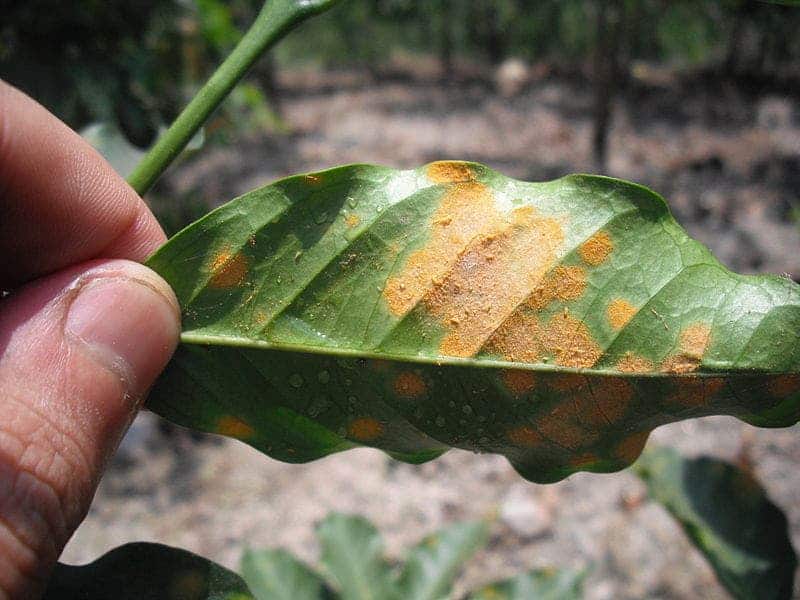As the third most consumed beverage in the world, after water and tea, coffee beans are in high demand everywhere. Second only to oil, coffee is among the world’s most traded commodities, with about half a trillion cups consumed per year. However, a pestilent fungus for which there is no cure is threatening to decimate coffee crops throughout South and Central America, which accounts for most of the world’s production of tasty Arabica beans.
The biggest coffee crisis in 150 years
The disease, known as coffee leaf rust, is caused by the fungus Hemileia vastatrix. When its spores — which can survive for months and travel airborne — come into contact with the coffee plant’s leaves, they germinate and penetrate that leaf within hours.
The first observable symptoms are small, pale yellow spots on the upper surfaces of the leaves. As these spots gradually increase in diameter, masses of orange urediniospores appear on the undersurfaces.
Eventually, the leaves start falling off, reducing the amount of essential nutrients that the plant receives. The disease does not outright kill the plant but it drops its yield to feeble levels, essentially choking the coffee plant.
It’s the same disease that was responsible for the famous coffee crash in Sri Lanka (formerly known as Ceylon) in the mid-1800s. Sri Lanka was once the leading coffee producer in the world, responsible for exporting over 100 million pounds annually of the commodity. Within a decade after the first signs of the diseases hit the island, exports fell by 80%. Two decades later, exports were down 90% relative to levels recorded before the outbreak.
The fungus later appeared in coffee farms across Africa, decimating plantations, but somehow wasn’t able to infect Latin America — which, today, produces seven-eights of the world’s Arabica coffee — until the 1970s, when it first appeared in Brazil, sowing panic among coffee farmers and trade organizations. As NPR reports, coffee leaf rust steadily spread throughout the continent, despite farmers’ best efforts to stave off the diseases through measures like replanting or the use of genetically-modified breeds that have more resistance to the fungus.
The last decade has been particularly merciless. In Central America, 70% of Arabica farms have been hit by the disease, resulting in $3.2 billion in damage and 1.7 million lost jobs.
Although scientists have been aware of H. vastatrix for more than a century, the fungus is still poorly understood, so there is no cure or meaningful way to help farmers prevent the rust. The challenge lies in the fact that rust fungi are obligate parasites — which must also infect a host in order to survive, spread, and fulfill their lifecycle — so it is difficult to get ahold of pure DNA. This also means that you can’t grow the fungi in culture or manipulate them in the lab. What’s more, these are microfungi — small organisms embedded in their hosts, which are challenging to study.
But that doesn’t mean that scientists aren’t tackling the challenge. Work is now underway in order to understand the rust fungi’s reproductive processes and to sequence its full genome. In the meantime, coffee farmers will have to brave the situation with whatever little resources they have left. And, as if rust fungi weren’t enough, farmers have another huge threat looming over their livelihoods — climate change. According to a 2017 study, “coffee-suitable areas will be reduced by 73–88% by 2050 across warming scenarios, a decline 46–76% greater than estimated by global assessments.”










